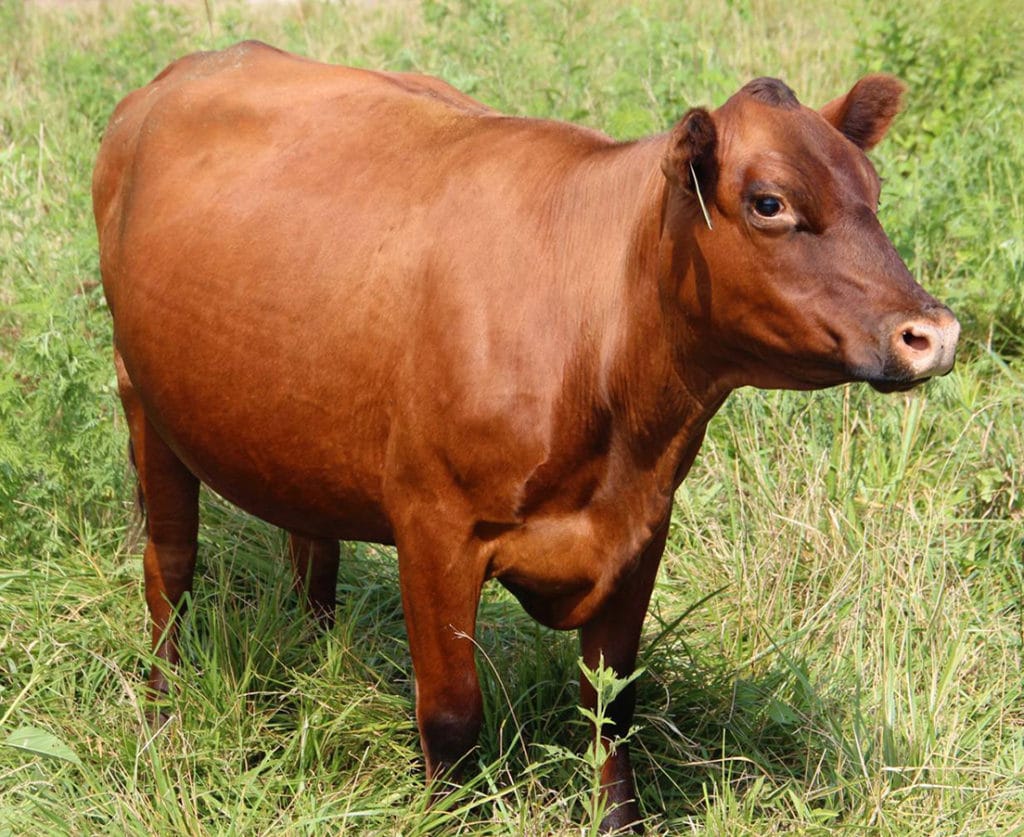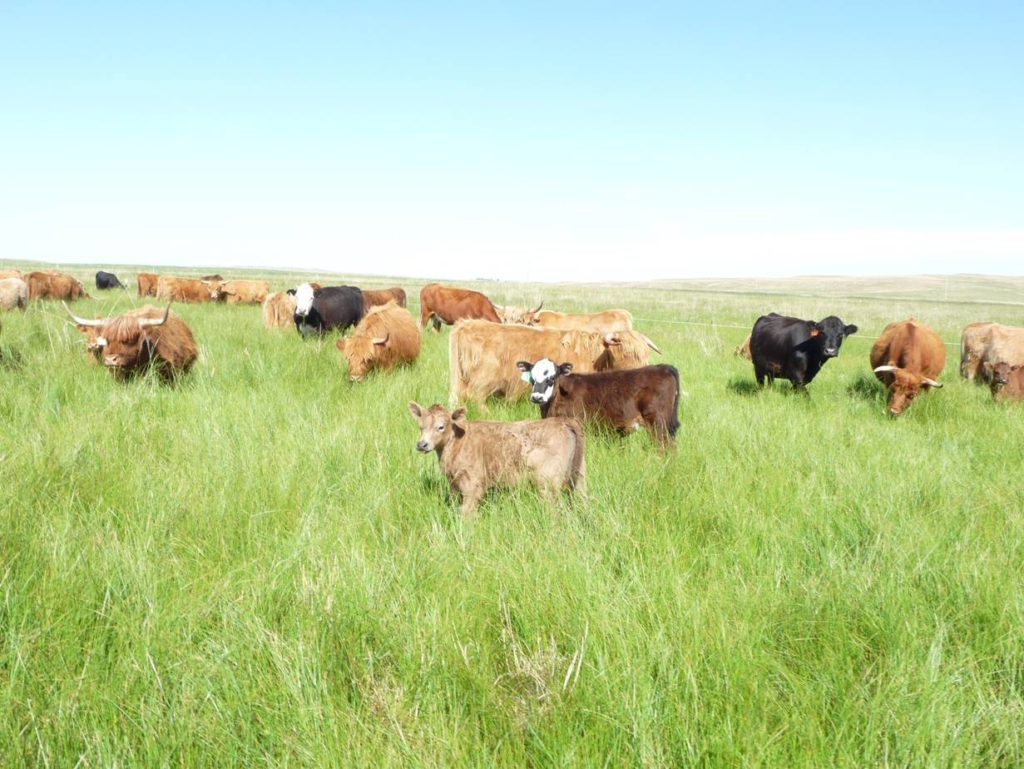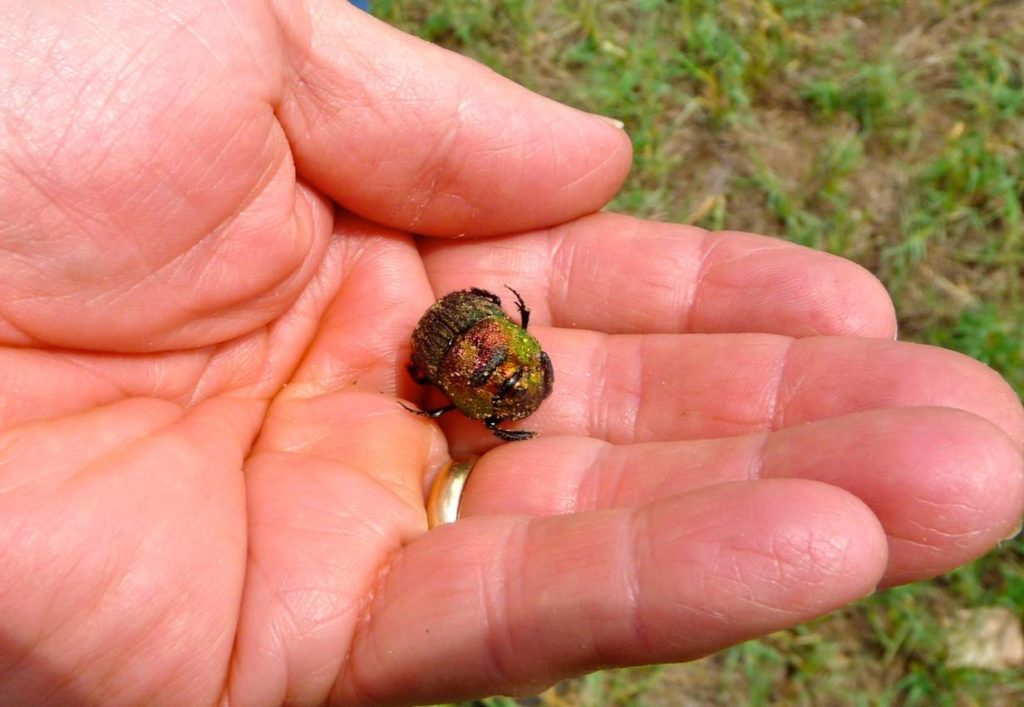Raising Your Own Grass Fed Beef
By Will Winter
There are few agricultural activities more exciting these days than being able to make and sell your very own gourmet 100 percent grass-fed beef.
Likewise, in that location are few agronomical activities that can be as frustrating to larn. Mistakes with animals on this scale can exist large and devastating so it's non just important to plan alee, but maybe even more important to avert the mistakes others have made.
Demand for grass-fed beef continues to ascent, whereas the feedlot beef industry is stagnant. When yous attend a conference these days, the packed classrooms are the ones explaining grass-fed beefiness product.
Getting off on the right pes is important. It'due south a mutual mistake to assume that ane tin can just throw some mediocre auction barn cattle onto old worn-out row crop land and come back in a year or two to observe glistening happy cattle that are fully fattened and gear up to go to town. I'thou not saying that information technology can't be done, but that it'southward not very likely to piece of work that way. For one affair, most mod cattle are no longer structured in a manner to achieve this, nor is the quality of our grass what information technology once was. Just considering it'due south green doesn't mean there is anything in it.
Practiced old grass, that is nutrient-dense, loftier-Brix and abundant, has become difficult to find anywhere, but particularly in the land formerly known equally the Not bad Plains. Take Iowa for example (please). This country, earlier we got here, was lxx-fourscore percent polyculture perennial prairie loaded with millions of bison. The stocking density was incredible, and the annual "harvest" by the ruminants merely made information technology meliorate. Now the prairie has been reduced to less than 0.01 percent of its original size. The few remaining bison are mostly nourished, fattened anyhow, from silage and grain, just like the cattle, hogs and poultry.

A few years agone, in Ankeny, Iowa, just outside Des Moines, I gave a lecture to an audience of organic farmers and ranchers almost how one could become a producer for Thousand Hills Cattle Co. (Then, as now, THCC is actively recruiting new producers.)
After going through several hours of fiscal and nutritional data derived from producers, I asked if in that location were whatsoever questions. An organic corn producer raised his hand and stated, in all seriousness, "I withal don't sympathise why I would desire to accept my land out of production …" I wasn't certain how to respond to that comment, given that I had just shown figures explaining how the top producers who stop
100 percent grass-fed cattle were pocketing $500 or more profit per acre per year. It'due south even more interesting given the fact that I had shown how this is possible with virtually no heavy farm implements (or bank loans) at all, and with the assurance that the cost one can receive for properly-raised beef will not have the extreme price fluctuations seen with commodity beef — or, for that matter, similar prices fluctuate with article grains. Grass-fed beef producers could exist "price-makers" non "cost-takers."
I'm kind of picking on Iowa in particular these days — non because it's unique, in fact, nearly of the states in the Midwest have lost their fertility and prairie to the lure of corn, beans and factory farms — just because there is so much potential for modify there.
Iowa was a state that one time held 8-ten feet of deep black topsoil, one that still has adequate rainfall, as well as a wonderful growing season and climate.
Merely sadly, this sometime Garden of Eden is now a place that imports over 90 percent of the nutrient to feed its residents.
I work a lot in Iowa. I was there recently during a sudden downpour that turned into a torrential storm. Driving the back roads, I saw nigh instant flooding, the kind that occurs when the soil has about no ability to absorb rainwater (chosen infiltration when it occurs), and virtually no embrace crops to protect from soil loss in runoff.
The streams during and following this torrent of rain were heartbreakingly filled with a chocolate mocha-like mixture of soil, and the water itself was headed s in the flooded rivers and streams: farmland fertility headed to the Gulf of Mexico. Several days after a multi-inch rain this kind of land is back to beingness in a drought!
The expert news is that I am watching start-up ranchers and fifty-fifty old-time ranchers reverse the process. All the information ane needs to restore the land is bachelor and for some who are willing to be aggressive nearly it, progress can be fabricated in as little every bit one yr. In fact, just restoring natural grazing can bring back fertility itself, and by "natural" I mean some form of rotational grazing, mimicking the grazing habits and patterns of bison and other large ruminants, which were a critical part of the development of the rich topsoil and organic affair of grasslands everywhere. The even better news is that by using advanced techniques and technology, change can be accelerated greatly.
So, what if the only thing a person can first with is rental state? No problem!
Many of the best techniques for increasing production are so cost-effective that rental ground tin can become an first-class money-maker. Sure, we are "fixing up" someone else'due south land, just at the end of the day, it'due south all good.
Here are my meridian 10 methods to apace transform worn-out row crop land, rental ground, returning CRP land, or the typical overgrazed, eroded, weed-infested and driveling pasture dorsum into assisting and sustainable production:
1. Start With a Plan
Expert consultants can help new producers determine the major factors that practically make up one's mind what your farm wants to be. It varies with your own detail geography, topography, meteorology, geology, sociology, biology and psychology. This could include which species, say sheep, goats, pigs, or cattle, or, ideally some of each. Biodiversity is the heart and soul of regenerative agriculture. Volition you attempt to certify for organic, biodynamic or other designations?

Not every farm or ranch tin can stop gourmet grass-fed beef; they might, however, exist excellent for a cow-calf operation. Almost whatever grassland will work for keeping mama cows fatty and happy, but the all-time grass fertility and food density is required for the terminal finishing. Many small producers begin with moo-cow-calf and then evolve into finishing.
2. Rent a Practiced Consultant
This is something near of us take a hard fourth dimension doing. But still, the older I get, the more I realize that I don't know everything. It's nothing to be ashamed of! Proficient advice can shorten the path to success by many years.
Practiced advice will almost always prevent bankruptcy and failure. Adept communication is also very easy to detect these days. An ideal identify to outset is right here within the pages of Acres U.S.A. magazine. These specialists accept been honed by the editors over many decades, so the odds of success in this gene pool are very high. The main variable is to find the one(s) that are aligned with your item style and preferences.
3. Read & Report
You lot have a cracking magazine in your hands right at present! In that location are many. I consider the internet an invaluable resources these days. In fact, every day I can meet the terrible handicaps of those who cannot access the cyberspace, and those individuals are fifty-fifty more implicitly urged to expand their library.
Joel Salatin told united states once that the first affair he does when visiting a farm is to bank check out their library of books. I know for a fact that there is a book, or ordinarily many books, that give explicit details of each of these 10 steps, and they can exist found right at the largest eco-agriculture bookstore in the earth, Acres U.South.A.
four. Soil Testing
Go some adept soil tests done at the very beginning. Information technology is of utmost importance to find out what elements are missing, what elements are strong and the overall motion picture of soil health.
You volition also want to have a waypoint on your growth map showing where you began. My advice is to eschew common labs that focus on NPK fertility and what might be called "mod soil chemistry." Most extension services are like this, but go with the labs that offer deep analysis of the soil. I send most of my soil tests to Texas Establish and Soil Lab, non just because they give me the almost valuable data, but because they help landowners chart a course toward sustainable restoration. I similar them because they likewise do not sell anything, and so they are less probable to recommend expensive soil amendments. In that location are many other great labs. Nosotros are basically talking nigh finding a lab that will help access acceptable data about the three basic soil principles of chemistry, structure and biological science — the latter being extremely important.
five. Mapping the Country
One of the all-time tools for this procedure utilizes the most modern technology, which falls under the rubric of pasture mapping. In fact, the visitor
I recommend is chosen PastureMap. In addition to the apply of satellite and drone photography, they will quickly assistance determine the most efficient and accurate paddock partitioning, where to put fences and make up one's mind the all-time place to run water lines and lanes. If ane continues with their services, they assist in helping determine stocking density, grazing patterns and moves every bit well as ongoing livestock direction.
6. Pasture/Field Remediation

If old GMO row cropland is to be used, it'due south of import to find tools that can mitigate and speed upward the destruction of residual pesticides and chemicals that reside in the soil. In addition to the use of bootleg or purchased compost tea preparations, I apply biological products from several cut-edge companies, just primarily I use the foliar sprays from Nature's Best LLC out of Inwood, Iowa. For every bit trivial as $7-$10 per acre, I use these sprays to begin the organic destruction of glyphosate and other nasty chemicals.
They also begin the process of restoring biological science to the soil itself. This soil biological science, in my opinion, is the most important critical aspect of creating a fertile, nutrient-dense, non-toxic and productive farm. After establishing a policy of no poisons ever, then adding new biology, we will create a protective bio-film that covers every square inch of the property, healing the land, and protecting everyone and everything confronting mortiferous pathogens.
7. Bringing In Fertility
Now this topic will create controversy, and I'g bound to footstep on some toes. All the same, some things must be said. Having mentioned that I spend a lot of time in Iowa, I can attest to being witness to one of the most irritating and wasteful sins of agriculture, the spreading of massive quantities of feedlot or lagoon pit manure on the land. From the center, olfactory organ and throat irritation that rural Iowans are forced to suffer, to the enormous loss of pure nitrogen (usually in the form of ammonia) going up into the air and atmosphere also as the tremendous leaching of even more nitrogen and peculiarly phosphorus into the aquifers and streams. Downstream pollution of nitrogen is toxic to humans and animals, and the accrual of excess phosphorus runoff causes toxic algae blooms and dead zones.
My number i choice of brought-in fertility is to purchase the absolute best composted manure bachelor.
As one case, in Iowa I have been working with Bar K Ranch and their supply of composted manure. Their 100,000 feedlot cattle create over 100,000 tons of compost annually, and information technology is the cheapest grade of imported fertility you will e'er detect. You lot get more than than 100 percent of your expenditure dorsum just in NPK additions alone, and then the bonus is all the biology and skilful humus within. At a rate of 4 tons per acre per year, it's an incredible method of accelerating fertility, organic matter, tilth, sward thickness and stocking density. Obviously, the other pick is to import chemical fertility itself, such as lime, dolomite and other chemicals; however, the largest drawback is price. Chemic fertility correction can total more than the price of the land then information technology'south usually out of the question for rented land.
8. Fencing & Improvements for Livestock
Oh, aye, this will be essential. This category likewise tends to include gates, loading/treatment facilities, h2o tanks, mineral feeders, shade and shelter from wind and weather.
It also goes back to our earlier steps of planning and mapping. A potent perimeter contend is a given. Double that statement for bison, sheep, or especially goats. This expenditure becomes about glaring for rental country. Greg Judy has written extensively about the methods he uses for covering the costs of the essential basics for bringing in livestock to land owned by others. Typically, row cropland will come up unfenced or poorly fenced, then that must be taken into consideration.
Perimeter fencing, from scratch, begins at almost $1 per running pes, on up. Once the perimeter debate is upward and strong, it's much easier to work with the dividing fences that command grazing patterns and allow for rotational or mob-and-move styles of grazing. One can safely say that electrical fencing has made rotational grazing possible.
9. Stored Forages for Winter
The necessity of feeding hay may also include other periods of the year, depending upon the climate and latitude. The late Allan Nation, publisher of The Stockman Grass Farmer, said he traveled our continent from Canada to Mexico and constitute that basically everyone utilizes hay or other stored forages for approximately iv months a year no matter where they alive. In response, information technology prompted agronomist Jim Gerrish to write the book, Kick the Hay Addiction.
Mod improvements in thinking regarding stockpiled forages, encompass-cropping and in the creation of robust genetics for bovine foraging accept lessened the dependence on hay. However, bringing in hay or other forages is an incredible boost toward the fertility of a farm or ranch. Todd Churchill, founder of Thousand Hills Cattle Co., estimates that there are over $90 worth of minerals in every ton of hay! This way one feeds not only the livestock but also the soil and forages.
x. Like shooting fish in a barrel-Keeping Cows & Grass Genetics
Much ink has been spent on this category, and fortunes have been made and lost with skillful and bad decisions over genetics. 1 can safely say that tremendous damage has been done in the concluding century to dumb-downward creature physiology to make them work in the feedlot. These are the animals you will most likely find, unless yous know where to look and what to look for.
If the livestock originally imported by the immigrants and settlers, for instance the old Aberdeen Angus, were to exist used in a feedlot, they would be too good. They would quickly develop a massive layer of undesirable and excess back fatty. Equally bad for the feedlot industry, they would fatten too quickly due to the fact that the basic reason we have feedlots is to find the most inefficient method of getting rid of our mountains of backlog government-subsidized grain.
Grass-genetics bovine geneticist Steve Campbell says that when information technology comes to being easy-keepers on grass, the demographics of most herds in the United states resemble a bong-shaped curve with the best five-10 per centum being extremely desirable with the majority, which make up the hump at the top of the bell, being average to mediocre, and then another 5-10 pct or then at the bottom being the extremely undesirable slab-sided, rangy, bony ones that don't work well on grass. He offers long- and curt-term plans for the culling and selection techniques such that any herd can exist shaped so as to get to the eventual goal of having the bulk of the animals be the ones that are the money-makers on grass.
Call information technology a blueprint for the future or just call information technology your grass-fed beef ranching plan, simply what you lot have simply read is not an experiment or a theory. Information technology adds upwardly to a time-tested plan that will work for anyone who is serious about making the leap to grass-fed animals. The fact is that the evolution from grain-fed ruminants going back to their roots every bit God-designed grass-munchers is as certain as the ongoing ecological switch from burning coal for energy to converting to a time to come fueled past alternative fuels — and someone will need to be there to produce what more and more than consumers want to eat. No matter how you get in that location, there is gold at the end of this rainbow. Getting there as quickly and efficiently equally possible simply makes sense; besides, there is no value in making the mistakes others have made if it tin can be avoided. Every bit they say, feel is the best instructor, to which I would add together, preferably somebody else's! The rest is upwardly to you.
This commodity appeared in the June 2017 consequence of Acres United states of americaA.magazine.
Will Winter is a holistic herd health consultant and livestock nutritionist as well as a traveling instructor focusing on sustainable livestock product and traditional nutrition. Reach him at willwinterdvm@gmail.com or Grass Farmer Supply.
Source: https://www.ecofarmingdaily.com/raise-healthy-livestock/cattle/grass-fed-beef-10-keys-to-getting-started/
0 Response to "Raising Your Own Grass Fed Beef"
Post a Comment